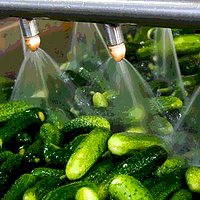Keeping Clean Labels Simple for Safer, Healthier Food

Credit: SDI Productions/E+ via getty Images
Growing health-consciousness among consumers has compelled them to know exactly what ingredients are present in their food and where it comes from. This has led to the rise of clean labeling. With the belief that healthier and ethically sourced and produced products can be found on simple labels, consumers are increasingly choosing products with fewer additives and fewer artificial or chemical sweeteners.
Food companies are engaging in a cultural shift in response to this growing preference. For example, Nestle has already removed artificial ingredients from its products and is opting for clean labels. Clean labeling is not only limited to the ingredients, but also applies to the packaging techniques and technologies used during manufacturing.
Active Packaging for Enhanced Safety
Food packaging innovations present new opportunities to maintain food safety and quality beyond the basic goals of conventional food packaging, such as containment, protection, convenience, and communication. To ensure overall food safety and quality, active packaging has been used to prevent lipid oxidation, inhibit microbial growth, and control ripening. Products such as meat, snacks, cheese, and cereals are kept fresher for longer with active packaging.
The use of active packaging is growing for clean-label products as they lack some preservatives, additives, and stabilizers. For example, snack foods that do not contain butylated hydroxyanisole, tert-butylhydroquinone, butylated hydroxytoluene, and trans-unsaturated fatty acids have an increased tendency to oxidize lipids and, therefore, require clean labeling.
Although controlled atmosphere packaging (CAP) and modified atmosphere packaging (MAP) have been in use for many years, they are now being applied to new categories of food that previously relied on ingredients that could not be classified as "clean label." Applications such as CAP and MAP require specialized control of barrier properties that range from highly porous micro-perforated packages to highly superior barriers made from ethylene-vinyl alcohol (EVOH), metalized film, aluminum foil, and nanotechnology.
For example, many clean-label snacks require nitrogen flushing to inhibit oxidation and, sometimes, carbon dioxide if the water activity is above 0.65 within high-barrier packaging. By combining a gas flushing process with high barriers and temperature controls, oxygen absorbers reduce the likelihood that meats, dried fruit, cereals, and other products will be exposed to oxygen. In controlled-atmosphere rooms, produce is left to ripen in the proper conditions throughout the distribution process. Thus, permeable packaging within corrugated boxes is necessary to allow the rapid exchange of gases. For clean-label products, this process is more tightly controlled and enhances the "clean" aspect of the products.
Ethylene Scavenging: An Active Packaging Technique
Several stakeholders, including farmers, vendors, and suppliers, apply artificial additives to regulate and accelerate the ripening process of fruit. Clean-label formulations consider the use of additives in fruits and vegetables to be undesirable and objectionable due to the potential health hazards they pose. Ethylene, one such additive, also accelerates the degradation of chlorophyll, especially in various leafy vegetables and specific fruits. To control the rate of ethylene gas in packaged fruits and vegetables from the package, headspace can be used to extend the shelf life and reduce senescence.
Ethylene scavenging can be used to control specific components in a clean-label formulation. Packaging fruits and vegetables with ethylene scavengers is considered a practical way to reduce the production of ethylene. As a result, the concentration of ethylene gas generated within each package is controlled by an ethylene scavenger embedded in pads, sachets, films, and coatings. As these ethylene components do not come into direct contact with the product, they are considered to be clean-label ingredients. However, active packaging systems, such as ethylene absorbers and emitters, have enough potential to increase the shelf life of fruits and vegetables and give them a "clean" attribute.
For example, the Association of Marketing and Exportation of Bananas of Ecuador (ACORBANEC) has decided to promote the use of "It's Fresh! Technology" in the country's banana-growing community. The "It’s Fresh!" filters absorb the ripening hormone ethylene from fresh fruit and vegetables, extending the green life of bananas throughout the various operations of the supply chain. This partnership marked a turning point for "It's Fresh!" and its commitment to reduce food waste worldwide. However, the future progress and application of ethylene scavenging packaging will depend on its acceptance and cost-effectiveness in substantiating its suitability for clean-label formulation among food processors.
Case Study on Clean-Label Corn Starch
In France, Yuka is an app that gives a real-time report of what ingredients are in a product and makes recommendations of alternative options. Yuka found that the ingredient list of a leading European macaron brand did not persuade consumers to buy the products. This European bakery manufacturer realized that to protect its market share and to stand up to consumer scrutiny at the point of purchase, it needed to clean up the labels on its macaron products.
Ingredion's formulation and technical expertise were combined with groundbreaking ingredient application to cost-effectively and successfully meet this texture challenge. Formulation expertise, production line expertise, and prototyping capabilities were essential to solving the macaron company's problem.
The solution ingredient performed better than those of other suppliers in a head-to-head comparison. A clean-label starch, it is ideal for frozen meals, sauces, and fruit preparations, which can be kept for extended periods in a refrigerated or frozen environment to preserve their taste and texture. In addition to providing instant viscosity and process tolerance, the solution ingredient also offers exceptional freeze-thaw stability, which is beneficial for instant and ready-to-eat products with a longer shelf life.
Increasing the Shelf Life of Clean-Label Products
To increase the shelf life of the products in clean-label ingredients, several technologies have been employed. High-pressure processing (HPP) is a method of preserving packaged food products using extremely high pressure. This process eliminates harmful bacteria while still preserving vitamins, minerals, and various enzymes, as well as preserving a fresh taste. The technology can be applied to a variety of fresh foods, including poultry and meat, to extend shelf life without preservatives.
Additionally, HPP meat products can be reduced in sodium, enabling sodium reduction claims on clean labels. For example, Sassy Lassi, a Texas Food Solutions company, uses HPP to produce its kids' yogurt drinks. Sassy Lassi's yogurt drinks use only three organic ingredients: cultured whole milk, organic cane sugar, and organic fruit juice. Sassy Lassi uses HPP to keep its products safe to consume while maintaining a fresh flavor and full nutritional value.
A clean label relies on not only a pathogen-free product with fewer undesirable ingredients, but also a shelf life that takes into account logistics and production schedules to provide a longer period of freshness than a traditionally processed product.
Looking for a reprint of this article?
From high-res PDFs to custom plaques, order your copy today!






